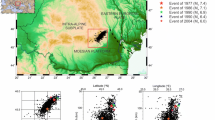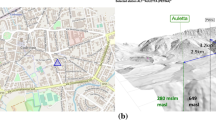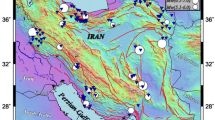Abstract
Macroseismic intensity data are an important source to learn from historical earthquakes. Nevertheless, this data needs to be converted into more suitable intensity measures to be used in risk analyses, as well as in design practice. To this purpose, in this paper, correlations between macroseismic scales and ground motion parameters have been derived. Peak Ground Acceleration (PGA), Peak Ground Velocity (PGV) and Housner Intensity (IH) as instrumental measures, and European Macroseismic Scale (EMS-98) and Mercalli-Cancani-Sieberg (MCS) as macroseismic measures, have been considered. 179 ground-motion records belonging to 32 earthquake events occurred in Italy in the last 40 years have been selected, provided that for each record, macroseismic intensity in terms of either EMS-98 or MCS or both were also available. Statistical analyses have been carried out to derive both direct (i.e. macroseismic vs instrumental intensity) and inverse (instrumental vs macroseismic intensity) relationships. Results obtained from the proposed relationships have been analyzed and compared with some of the most prominent results available in the technical literature.














Similar content being viewed by others
References
Arcoraci L, Berardi M, Castellano C, Leschiutta I, Maramai A, Rossi A, Tertulliani A, Vecchi M (2009) Rilievo macrosismico del terremoto del 15 dicembre 2009 nella Valle del Tevere e considerazioni sull’applicazione della scala EMS98. Available at website http://quest.ingv.it
Arcoraci L, Berardi M, Brizuela B, Castellano C, Del Mese S, Graziani L, Maramai A, Rossi A, Sbarra M, Tertulliani A, Vecchi M, Vecchi S, Bernardini F, Ercolani E (2012a) Rilievo macrosismico degli effetti del terremoto del 25 gennaio 2012 (Pianura Padana). Available at website http://quest.ingv.it
Arcoraci L, Berardi M, Bernardini F, Brizuela B, Caracciolo CH, Castellano C, Castelli V, Cavaliere A, Del Mese S, Ercolani E, Graziani L, Maramai A, Massucci A, Rossi A, Sbarra M, Tertulliani A, Vecchi M, Vecchi S (2012b) Rapporto macrosismico sui terremoti del 20 (Ml 5.9) e del 29 maggio 2012 (Ml 5.8 E 5.3) nella Pianura Padano-Emiliana. Available at website http://quest.ingv.it
Arcoraci L, Bernardini F, Brizuela B, Ercolani E, Graziani L, Leschiutta I, Maramai A, Tertulliani A, Vecchi M (2013) Rapporto macrosismico sul terremoto del 21 giugno 2013 (ML 5.2) in Lunigiana e Garfagnana (province di Massa-Carrara e di Lucca). Available at website http://quest.ingv.it
Azzaro R, Barbano MS, Camassi R, D’Amico S, Mostaccio A, Piangiamore G, Scarfì L (2004) The earthquake of 6 September 2002 and the seismic history of Palermo (Northern Sicily, Italy): implications for the seismic hazard assessment of the city. J Seismolog 8:525–543
Azzaro R, Mostaccio A, Scarfì L, Tuvè T (2011) Rapporto macrosismico sul terremoto dei Nebrodi del 24/06/2011. Available at website http://quest.ingv.it
Azzaro R, D’Amico S, Scarfì L, Tuvè T (2012) Aggiornamento al rilievo macrosismico degli effetti prodotti dal terremoto del Pollino del 26 ottobre 2012. Available at website http://quest.ingv.it
Azzaro R, D’Amico S, Mostaccio A, Scarfì L, Tuvè T (2016) Rilievo macrosismico del terremoto Ibleo dell’8 febbraio 2016. Available at website http://quest.ingv.it
Bernardini F, Ercolani E (2011a) Rilievo macrosismico degli effetti prodotti dal terremoto del 17 luglio 2011 nella Pianura Padana lombardo-veneta (province di Rovigo, Mantova, Modena e Ferrara). Available at website http://quest.ingv.it
Bernardini F, Ercolani E, Del Mese S (2011b) Rapporto macrosismico sul terremoto torinese del 25 luglio 2011. Available at website http://quest.ingv.it
Braga F, Dolce M, Liberatore D (1982) A statistical study on damaged buildings and ensuing review of the MSK-76 Scale. In: 8th ECEE, Atene
Burnham KP, Anderson DR (1998) Model selection and multimodel inference: a practical information-theoretic approach. Springer, Telos
Camassi R, Ercolani E (2003a) Rilievo macrosismico del terremoto del 26/01/2003 (Forlivese). Available at website http://quest.ingv.it
Camassi R, Bernardini F, Ercolani E (2003b) Rilievo macrosismico degli effetti prodotti dalla sequenza sismica iniziata il 14 settembre 2003 (Appennino Bolognese). Available at website http://quest.ingv.it
Camassi R, Bernardini F, Del Mese S (2008) Rilievo macrosismico degli effetti prodotti dalla sequenza sismica del 1 marzo 2008 (Appennino Bolognese, Mugello). Available at website http://quest.ingv.it
Camassi R, Ercolani E, Bernardini F, Pondrelli S, Tertulliani A, Rossi A, Del Mese S, Vecchi M (2009) Rapporto sugli effetti del terremoto emiliano del 23 dicembre 2008. Available at website http://quest.ingv.it
Chiauzzi L, Masi A, Mucciarelli M, Vona M, Pacor F, Cultrera G, Gallovic F, Emolo A (2012) Building damage scenarios based on exploitation of Housner intensity derived from finite faults ground motion simulations. Bull Earthq Eng 10:517–545
Chioccarelli E, De Luca F, Iervolino I (2012) Preliminary study of Emilia (May 20 h 2012) earthquake ground motion records V2.11. Available at website http://www.reluis.it
Codermatz R, Nicolich R, Slejko D (2003) Seismic risk assessments and GIS technology: applications to infrastructures in the Friuli-Venezia Giulia region (NE Italy). Earthq Eng Struct Dyn 32:1677–1690
Dolce M, Masi A, Marino M, Vona M (2003) Earthquake damage scenarios of Potenza town (Southern Italy) including site effects. Bull Earthq Eng 1(1):115–140
Dolce M, Kappos AJ, Masi A, Penelis G, Vona M (2006) Vulnerability assessment and earthquake scenarios of the building stock of Potenza (Southern Italy) using the Italian and Greek methodologies. Eng Struct 28:357–371
Faccioli E, Cauzzi C (2006) Macroseismic intensities for seismic scenarios, estimated from instrumentally based correlations. In: European conference on earthquake engineering and seismology, Geneva, Switzerland, 3–8 September 2006
Faenza L, Michelini A (2010) Regression analysis of MCS intensity and ground motion parameters in Italy and its application in ShakeMap. Geophys J Int 180:1138–1152
Galli P, Camassi R (2009) Rapporto sugli effetti del terremoto aquilano del 6 aprile 2009. Available at website http://quest.ingv.it
Galli P, Molin D, Camassi R, Castelli V (2001) Il terremoto del 9 settembre 1998 nel quadro della sismicità storica del confine calabro-lucano. Possibili implicazioni sismotettoniche. Il Quat Ital J Quat Sci 14:31–40
Galli P, Peronace E, Tertulliani A (2016) Rapporto sugli effetti macrosismici del terremoto del 24 agosto 2016 di Amatrice in scala MCS. Available at website http://quest.ingv.it
Gómez Capera AA, Albarello D, Gasperini P (2007) Aggiornamento relazioni fra l’intensità macrosismica e PGA, Technical report, Convenzione INGV-DPC 2004-2006
Grünthal G (ed) (1993) European Macroseismic Scale 1992 (EMS-92). European Seismological Commission, sub commission on Engineering Seismology, working Group Macroseismic Scales. Conseil de l’Europe, Cahiers du Centre Européen de Géodynamique et de Séismologie, vol 7, Luxembourg
Grünthal G (ed) (1998) European Macroseismic Scale 1998 (EMS-98). European Seismological Commission, sub commission on Engineering Seismology, working Group Macroseismic Scales. Conseil de l’Europe, Cahiers du Centre Européen de Géodynamique et de Séismologie, vol 15. Luxembourg
Gruppo di Lavoro INGV (2004) Rapporto preliminare sugli effetti del terremoto bresciano del 24 novembre 2004. Available at website http://quest.ingv.it
Housner GW (1952) Intensity of ground motion during strong earthquakes. Second technical report. August 1952, California Institute of Technology Pasedena, California
Margottini C, Molin D, Serva L (1992) Intensity versus ground motion: a new approach using Italian data. Eng Geol 33:45–58
Masi A (2003) Seismic vulnerability assessment of gravity load designed R/C frames. Bull Earthq Eng 1(3):371–395
Masi A, Digrisolo A (2015) Manfredi V (2015) Fragility curves of gravity-load designed RC buildings with regularity in plan. Earthq Struct 9(1):1–27
Masi A, Chiauzzi L, Braga F, Mucciarelli M, Vona M, Ditommaso R (2010) Peak and integral seismic parameters of L’Aquila 2009 ground motions: observed vs code provision values. Special Issue L’Aquila Earthquake. Bull Earthq Eng. https://doi.org/10.1007/s10518-010-9227-1
Masi A, Vona M, Mucciarelli M (2011) Selection of natural and synthetic accelerograms for seismic vulnerability studies on RC frames. J Struct Eng 137(3):367–378
Medvedev SV (1977) Seismic intensity scale M.S.K.—76. Publ Inst Geophys Pol Acad Sci A-6(117), Varsaw
Molin D (1995) Consideration on the assessment of macroseismic intensity. Ann Geophys 38:805–810
Montaldo V, Faccioli E, Zonno G, Akinci A, Malagnini L (2005) Treatment of ground-motion predictive relationships for the reference seismic hazard map of Italy. J Seismolog 9:295–316
Musson RMW, Grünthal G, Stucchi M (2010) The comparison of macroseismic intensity scales. J Seismol 14:413–428. https://doi.org/10.1007/s10950-009-9172-0
Petráš I. and Bednárová D. (2010) Total least squares approach to modeling: a matlab toolbox. Acta Montanistica Slovaca, Ročník 15 (2010), číslo 2, 158-170
Sieberg A (1930) Geologie der Erdbeben. Handbuch der Geophysik 2(4):550–555
Stucchi M, Galadini F, Monachesi G (1998) The earthquakes of September/October 1997 in the frame of tectonics and long-term seismicity of the Umbria-Marche (Central Italy) Apennines. Available at website http://emidius.mi.ingv.it/GNDT/T19970926_eng/
Tertulliani A, Azzaro R (2016a) Sequenza della provincia di Rieti. QUEST: Rilievo macrosismico in EMS98 per il terremoto di Amatrice del 24 agosto 2016. Available at website http://quest.ingv.it
Tertulliani A, Azzaro R (2016b) QUEST - Rilievo macrosismico per i terremoti nell’Italia centrale. Aggiornamento dopo le scosse del 26 e 30 ottobre 2016. Available at website http://quest.ingv.it
Tertulliani A, Azzaro R (2017) QUEST -Rilievo macrosismico in EMS98 per la sequenza sismica in Italia Centrale: aggiornamento dopo il 18 gennaio 2017. Available at website http://quest.ingv.it
Tertulliani A, Arcoraci L, Berardi M, Bernardini F, Camassi R, Castellano C, Del Mese S, Ercolani M, Graziani L, Leschiutta I, Rossi A, Vecchi M (2010) An application of EMS 98 in a medium size city: the case of L’Aquila (Italy) after the April 6, 2009 Mw 6.3 earthquake. Bull Earthq Eng. https://doi.org/10.1007/s10518-010-9188-4
Wald DJ, Quitoriano V, Heaton TH, Kanamori H (1999) Relations between peak ground acceleration, peak ground velocity, and modified mercalli intensity in California. Earthq Spectra 15(3):557–564
Worden CB, Gerstenberger MC, Rhoades DA, Wald DJ (2012) Probabilistic relationships between ground-motion parameters and Modified Mercalli intensity in California Bull. Seism Soc Am. 102(1):204–221. https://doi.org/10.1785/0120110156
Working Group ITACA (2017) Data base of the Italian strong motion data. Available at website http://itaca.mi.ingv.it
Zaiontz C. (2019) Real Statistics Using Excel, available on-line at www.real-statistics.com
Zuccaro G, Papa F, Baratta A (2000) Aggiornamento delle mappe a scala nazionale di vulnerabilità sismica delle strutture edilizie. In A. Bernardini A. (a cura di), La vulnerabilità degli edifici: valutazione a scala nazionale della vulnerabilità sismica degli edifici. Roma, CNR-GNDT, pp. 133–175
Acknowledgements
This study was partially developed under the financial support of the Italian Department of Civil Protection, within the ReLUIS-DPC 2019-2021 project. This support is gratefully acknowledged.
Author information
Authors and Affiliations
Corresponding author
Additional information
Publisher's Note
Springer Nature remains neutral with regard to jurisdictional claims in published maps and institutional affiliations.
Appendix
Appendix
1.1 Total Least Squares (TLS) method
According to Zaiontz (2019), the goal of the TLS method is to minimize the sum of the squared Euclidean distances d2 from the observed points \({\text{y}}_{\text{i}}\) to the corresponding ones on the regression line (which is in the form \({\text{y}} = {\text{a}} + {\text{bx}}\)), as follows:
that is equivalent to:
where \({\text{y}}_{\text{i}}\) and \({\text{y}}_{\text{i}}^{ '}\) are the observed and the corresponding estimated data (along the vertical line), respectively, and b is given by:
where
and
xm and ym are the mean values of the xi and yi values, respectively. The intercept a can now be expressed as:
An analogous procedure can be found also in Petráš and Bednárová (2010).
Rights and permissions
About this article
Cite this article
Masi, A., Chiauzzi, L., Nicodemo, G. et al. Correlations between macroseismic intensity estimations and ground motion measures of seismic events. Bull Earthquake Eng 18, 1899–1932 (2020). https://doi.org/10.1007/s10518-019-00782-2
Received:
Accepted:
Published:
Issue Date:
DOI: https://doi.org/10.1007/s10518-019-00782-2




